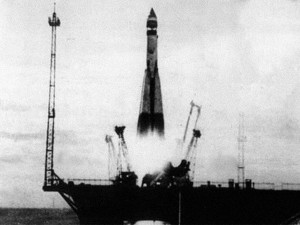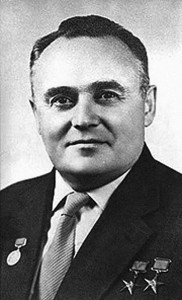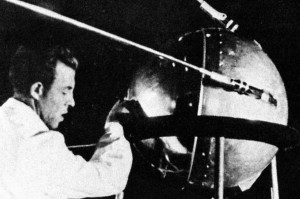Published on October 4, 2012
The beeping tones were incessant. By tuning onto the frequencies of 20.005 or 40.002 MHz, anyone the world over could listen to this simple repeating tone — yet what made it different was that it was broadcast from outer space, from on board the first satellite that orbited the Earth. The satellite was called Sputnik and it was launched by the Soviet Union, a nation that had openly stated that its rocket efforts were designed to develop a means of delivering nuclear weapons anywhere in the world in a matter of minutes. There was no denying it, the Soviet Union had beaten America into space — and it couldn’t have come at a worse time, hot on the heels of two US satellite launch failures and at a time when America was just starting to feel more secure about its defensive capabilities. The date was October 4, 1957, and for the next 22 days, until October 26th when the batteries finally ran out, the beeping was a constant reminder that a new and more dangerous phase of the Cold War had begun.

The Sputnik Panic
Every 96.2 minutes for the next 3 months, the satellite made an orbit. It traveling at approximately 18,000 mph in highly elliptical, low Earth orbit. Most critically, it appeared that the Soviets had not only proven the launch capability, but had solved the problem of how to keep electronics functioning in outer space. What was more shocking was that, as the data was released, it became clear that the Soviet achievement was no lightweight, miniaturized device, but rather a shining, highly polished sphere that measured 23 inches around and weighed a stunning 183 pounds. While American satellites were less than a tenth that size, it seemed that the Soviets were well on the way to being able to launch a full scale nuclear bomb and, if the electronics could function “out there”, then there was no doubt that the Soviet weapon would function once it came down on its target in America.
Reaction from within the Eisenhower Administration was swift. The President recognized a simple fact — Sputnik had created panic among the American people, within the defense department and within the halls of government and the US Congress. America’s prior confidence that the Atlantic and Pacific Oceans had offered strong protection from Soviet attack was swept away. Oceans were no match for satellites and it seemed that all of America was laid bare to Soviet attack. In response, President Eisenhower moved swiftly.

The challenges were many. America’s own space programs were underfunded, undermanned and under public scrutiny for repeated failures. This would have to be fixed. New civilian and military organizations would have to created. The government would have to invest more in higher education in the sciences. Above all was the strategic concern that the Russians would have more missiles and the capabilities to attack — of the will to attack, few in America doubted the Soviets’ desire to destroy the West.
A Political Crisis
Yet beyond the political and military issues, the Sputnik 1 satellite itself was a tiny revolution. Created by Sergei Korolev in the span of a few months of ad hoc work based on the energy and innovative spark of a small engineering team, Sputnik 1 rode atop the USSR’s new R-7 ballistic missile. Korolev knew that at best, he had a 40 percent chance of achieving orbit — indeed, of the first five R-7 rocket launches (the Soviet Union’s first ballistic missile), three had failed and two had succeeded. The longest range achieved being 6,000 km. Reentry of the warhead capsule had not been successful and additional engineering was underway — but that wouldn’t meant that a satellite couldn’t be put up into orbit if it was light enough.

When Korolev, ever the space visionary, realized the potential political import of a first satellite launch, he petitioned the Soviet leadership to use the next R-7 to put a satellite in space. The leadership seemed uninterested, desiring instead that the program proceed onward with nuclear weapons payloads. Eventually, however, they approved of the plan based on Korolev’s insistence. It seemed that he alone recognized that import that a satellite orbiting the Earth would have on the Cold War. Even in Washington, DC, President Eisenhower and other senior advisers considered that if the Soviets were first to launch, it would clear the way for the international use of space and have little more political impact. They too were confident of America’s prowess.
True to Korolev’s vision, when Sputnik launched, all of that changed. At first, the Russians had only issued a small mention of the satellite launch in their state-controlled media, a minor item of just another Soviet technical achievement among many. In America, however, the beeping of the satellite instantly took on dark meaning — if they could do that, they could put a bomb on Washington, DC, or on Chicago, or even on Yankee Stadium. And the larger question loomed, how had they done it? Seizing on the panic that was spreading through the West, the Soviets launched a major propaganda campaign aimed at boosting Soviet morale as well as further undermining the West’s confidence.

How Sputnik Worked
The R-7 rocket that carried Sputnik 1 launched from Site No.1/5, which was at the 5th Tyuratam range in Kazakh SSR. Nowadays, this site is called the Baikonur Cosmodrome and is located in the independent nation of Kazakhstan. Luckily, the R-7 performed perfectly, unlikely three of the previous five launches. The satellite separated from the top stage and its antennas snapped outward. It was a masterful design. To help control temperatures, the satellite was sheathed in a pair of half hemispheres of a polished alloy of aluminum, magnesium and titanium were connected together by 36 bolts and sealed with a set of O-rings. The inside was filled with nitrogen that was circulated by a small fan, helping to equalize internal temperatures from solar heating. The bulk of the weight was a 51 kg battery, which took up much of the space inside. Two transmitters were mounted and connected to four long, whip antennas that were mounted to the sides of the sphere. Temperature sensors and a basic telemetry package was installed which down linked the data via radio.
It was a beautiful little package and one that had been designed not just for efficiency, but visually to represent a new era in human history. By plan, the antennas were swept back from the sphere, a design reference to a comet. Sputnik was thus custom-designed for propaganda purposes, even if the Soviet leadership had shown little interest in it during its development. Yet once the Soviets could see how the Sputnik Panic had swept the West, the Sputnik’s unique shape was perfect for the newly crafted propaganda campaign, representing a modern, forward-looking and advanced Soviet nation. Soon, stamps, newspaper reports, and radio broadcasts were carrying word of Soviet achievements in space. As for Sergei Korolev and his team, he was given the go-ahead to launch a dog into orbit to test the feasibility of manned space flight.

America’s Response
In response to the Soviet achievement, three months later at the beginning of the new year of 1958, America would launch its first satellite, Explorer 1. Two months later, the second US satellite, Vanguard 1, would be launched. From the bones of NACA, a new agency would be created — the National Aeronautics and Space Agency, known more commonly as NASA. America had tasked itself with pioneering into space. Budgets at the National Science Foundation were quadrupled. Funding was allocated to US universities to promote research into space and investment into a new generation of space engineers. Amidst all of the public releases, one very quiet new agency was created within the Department of Defense — the Advanced Research Projects Agency (later DARPA), which would be tasked to pioneer new and brilliant technologies for America’s security and defense. Ultimately, in the 1960 campaign for the Presidency, John F. Kennedy would gain the upper hand by promising to “close the missile gap” with the Soviet Union by deploying no less than 1,000 of America’s own ICBMs.
A new and deadly phase of the Cold War had begun — the Space Race.
One More Bit of Aviation History
On November 3, 1957, just one day short of a month after the USSR’s successful launch of Sputnik 1, Sergei Korolev and his engineering team would triumph once again. Soviet Premier Khrushchev demanded that Korolev prepare a follow up launch to commemorate the Soviet Union’s 40th anniversary. Unlike Sputnik 1, however, the second satellite would carry a dog into space. Working nearly around the clock, the Soviets would launch Laika, a 13 pound mixed breed part-Samoyed terrier dog, into space. The dog was wired up to a whole set of biometric instruments, checking heart rate, body temperatures and more. Once in orbit, Laika ate some food from a small dispenser moved around laying down, sitting and standing up in a small padded chamber inside Sputnik 2. Sadly, due to insufficient cooling systems, Laika lived just a few hours in space, dying from overheating and stress. In the brief time she lived in space, however, Laika proved that many of the theories about the dangers of space radiation were overstated or, where they were present, could be addressed with science.
Today’s Aviation History Question
Laika was not the dog’s original name. What was the name and how was she selected for the mission?

Laika’s name was Kudryavka.
She was found on the streets.
This is a good story!